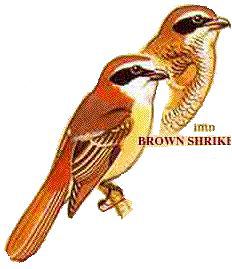by Salim Ali, Dillon Ripley & John Henry Dick (1983)

Brown Shrike (Lanius cristatus)
Adult: Entire upperparts including crown, rump and upper tail- coverts reddish brown; forehead and supercilium white; a black line through eyes to ear-coverts. Tail rufous-brown. Wings brownish black, edged rufous; no white 'mirror' or speculum. Below: chin, cheeks and throat white; rest pale fulvous, tinged with variable amount of rufescent on breast and belly. Sexes alike. Some adults have breast and belly and sides spangled with dark crescentic bars.
Status, Distribution & Habitat: Winter visitor. All India including NEFA, Assam, Nagaland and Manipur together with Nepal, Sikkim, Bhutan and E. Pakistan. Also winters in Ceylon (common) and the Laccadive, Maldive, Andaman and Nikobar islands. From plains level to c. 2100 m in the Himalayas and in the peninsular and Assam hills. Affects forest edges and clearings, secondary scrub jungle and grass-covered hillsides with scattered bushes and small trees etc. in dry-deciduous and semi-evergreen biotope. Arrives chiefly August-September: mostly gone by mid April, some individuals staying on till early June.
Extralimital: Breeds in Siberia from Tomsk to the Kolyma R. and Kamchatka south to N. Mongolia and N. Amurland. Winters also in Burma, Thailand, Malay Peninsula, Indochinese countries, etc. Some non-breeding birds apparently oversummer in the Andamans.
General Habits:Typical of the shrikes. Perhaps more crepuscular than others: commonly seen on the move and hunting till well after dusk, when also it is particularly noisy.
Food: Locusts, grasshoppers, crickets and other insects; sickly or fledgling birds, baby mice, lizards, etc.
Voice and Calls: A harsh loud swearing or scolding Chr-r-r-r commonly uttered: distinguishable from that of Rufous backed Shrike. Only sub-song occasionally heard in its winter quarters -- a sweet but faint, almost inaudible warbling, with mimicry of other bird-calls interlarded. Singing often detected only by the pulsations of the bird's throat and the accompanying up and down vibrations of the tail.
Breeding: Extralimital. Alleged nesting within Indian limits lacks substantiation. Adults have two complete moults-in spring and autumn -- in the winter quarters.